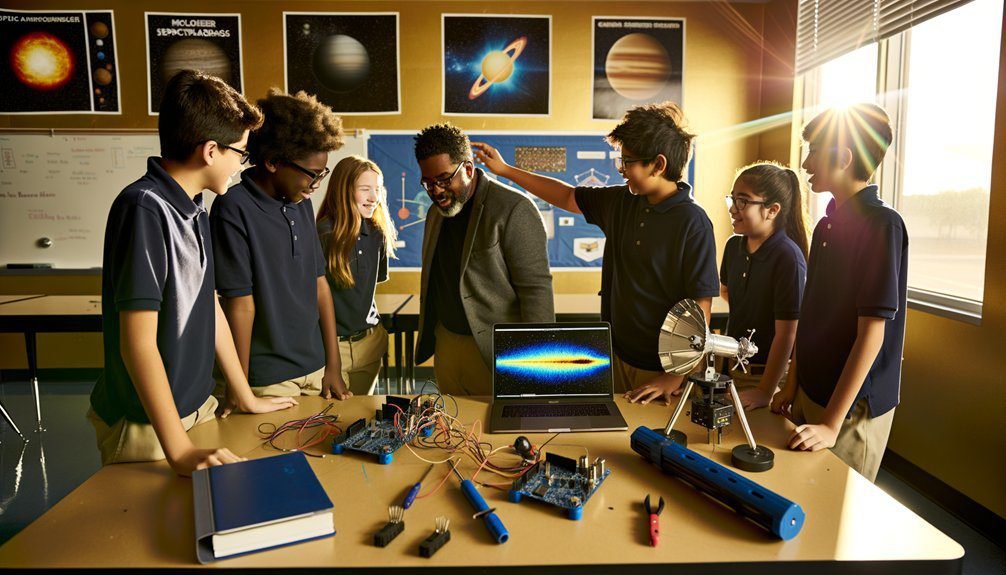You can follow SETI through public talks and lectures where researchers explain results in plain language. You can join citizen‑science projects to help sift data and flag interesting signals. You’ll get real‑time updates via social media and live streams with Q&A. Museums and public events offer hands‑on exhibits and stargazing nights. Schools partner with SETI for curricula and teacher training that use real data. Keep going and you’ll find details on how each connection actually works.
Key Takeaways
- Public science talks and lectures translate SETI findings into clear, relatable stories and explain uncertainties honestly.
- Citizen science projects let anyone analyze real data and flag interesting candidates for follow-up.
- Social media updates and live streams provide real‑time context, Q&A, and transparent progress reports.
- Museum exhibits, stargazing nights, and interactive kiosks let visitors explore candidate signals hands‑on.
- Educational partnerships supply classroom curricula, teacher training, and student projects using authentic SETI data.
Public Science Talks and Lectures

When you attend a public science talk about SETI discoveries, you’re stepping into a space where complex ideas are stripped down to their essentials and made relevant to everyday curiosity. You’ll hear researchers translate technical results into clear narratives, showing how signals are detected, vetted, and interpreted without needing a degree. Good science communication frames uncertainty honestly, explains methods simply, and invites questions so you can follow the logic. These talks also foster public engagement by creating dialogue: you’ll meet scientists, ask about implications, and see how discoveries fit broader scientific and cultural contexts. Presenters often use visuals, analogies, and real-world examples to make concepts stick, and they highlight why careful verification matters. By attending, you help shape priorities—feedback and turnout signal what the public values. That connection strengthens trust in the research process and makes the search for extraterrestrial intelligence a shared exploration rather than a closed, technical pursuit.
Citizen Science and Data-Analysis Projects
Although you don’t need a PhD to contribute, citizen-science and data-analysis projects let anyone help sift through the huge volumes of radio, optical, and infrared data used in the search for extraterrestrial intelligence. You’ll join crowdsourced research efforts that turn complex datasets into manageable tasks—classifying signals, flagging anomalies, and training algorithms. That hands-on work sharpens your data interpretation skills and directly supports professional analysis.
- Participate in platform-driven projects that guide you through signal recognition and pattern spotting.
- Use simple tools and tutorials to label images or time-series data, improving machine-learning models.
- Collaborate with forums and shared dashboards to compare findings and refine methods.
- Contribute flagged candidates that scientists can prioritize for follow-up, creating real impact.
Social Media Updates and Live Streams

Your contributions in citizen-science projects often lead to moments worth sharing, and social media updates and live streams let you follow those moments in real time. When SETI teams post concise updates, you get context quickly: what was found, why it matters, and what steps come next. Social media engagement makes those posts two-way — you can ask questions, share observations, and amplify findings to wider audiences. Live stream interactions take that further by letting you watch data analyses, telescope operations, or researcher discussions as they happen, and by enabling instant Q&A. You don’t need technical jargon to participate; hosts often explain methods and uncertainties in plain language. That transparency builds trust and helps you see how initial signals become vetted results. Regular updates and scheduled streams create predictable touchpoints, so you can follow progress without diving into raw papers. Overall, these channels make discovery a shared, real-time experience that invites ongoing curiosity and learning.
Museum Exhibits and Public Events
Because museum exhibits and public events bring SETI discoveries into shared, hands-on settings, they make complex science feel immediate and relevant to you. You can walk through interactive displays that translate radio signals, exoplanet data, and signal-analysis tools into tactile, visual experiences. Public lectures, panel discussions, and stargazing nights let you ask scientists questions and see methods firsthand. Outreach programs often partner with museums to create pop-up demos and traveling exhibits, so you can encounter discoveries outside academic journals.
- Audio-visual kiosks that let you isolate and visualize candidate signals.
- Hands-on signal-processing stations where you’ll try real data filtering.
- Public talks and Q&A sessions that explain significance without jargon.
- Outreach programs and pop-up exhibits at fairs and community centers.
These exhibits and events reduce distance between researcher and public, inviting you to participate, critique, and celebrate discovery in approachable, evidence-based ways.
Educational Partnerships and School Programs

When schools team up with SETI researchers, you get hands-on curricula, teacher training, and real data projects that bring the search for extraterrestrial intelligence into the classroom. You’ll see curriculum integration that aligns astronomy, coding, and critical thinking standards, and student engagement rises when learners analyze real signals or simulate signal processing. Teachers get resources and mentorship, while students practice inquiry, data literacy, and teamwork.
| Program Type | Age Range | Learning Outcome |
|---|---|---|
| Classroom Modules | 10–14 | Inquiry skills |
| After-school Clubs | 12–18 | Project work |
| Teacher Workshops | All | Pedagogical tools |
| Citizen Science | 14+ | Data analysis |
| Field Trips | K–12 | Contextual learning |
These partnerships demystify research, show career paths, and let you participate in authentic science. They’re practical, scalable, and designed so schools can adopt SETI content without adding undue burden.
Frequently Asked Questions
How Does SETI Handle False Positives and Hoaxes?
Like spotting two thunderclaps at once, you’d first get a swift verification: false alarm protocols kick in to check signals against known sources and instrument quirks. You’ll see repeated observations, cross-checks with other telescopes, and automated filters. If something’s fishy, hoax detection teams analyze metadata, provenance and human factors. You’ll be kept informed through transparent reports, and only robust, reproducible signals get public announcements to avoid premature claims.
Can the Public Access Raw Observational Data?
Yes — you can often access raw observational data, and SETI teams emphasize raw data accessibility to boost public engagement. Many projects publish datasets, calibration files, and observation logs online or through archives so researchers, students, and curious citizens can download and inspect them. You’ll find documentation, analysis tools, and community forums that help you interpret the data, report interesting features, and contribute to follow-up checks alongside professional scientists.
Are There Opportunities for Internships or Paid Research Positions?
Yes — you can join humming labs and quiet control rooms through internship programs and research opportunities that often mix hands-on data work with mentorship. You’ll shadow scientists, wrangle code, and help analyze signals, gaining real experience and sometimes pay. Positions vary from summer internships to longer fellowships; check SETI institutes’ and partner universities’ listings, and prepare a concise CV and project pitch to improve your chances.
How Is Funding Allocated for Public Outreach Versus Research?
Funding distribution balances public engagement and core research: you’ll see most funds go to data collection and analysis, while a steady portion supports outreach, education, and community programs. You’ll find grant proposals and institutional budgets specify percentages, and private donors often earmark gifts for engagement. That mix guarantees science stays rigorous while you’re kept informed and involved, with outreach scaled by available funding and strategic priorities.
Does SETI Collaborate With International Space Agencies?
Yes — you’ll find SETI teams working with international partnerships and collaborative missions. They often share data, coordinate observations, and join networks with space agencies and universities worldwide to follow up signals or study targets. You’ll see joint workshops, instrument sharing, and coordinated observing campaigns that leverage diverse expertise and facilities. This global cooperation boosts credibility, resource access, and rapid verification, so you’re part of a wider scientific effort.